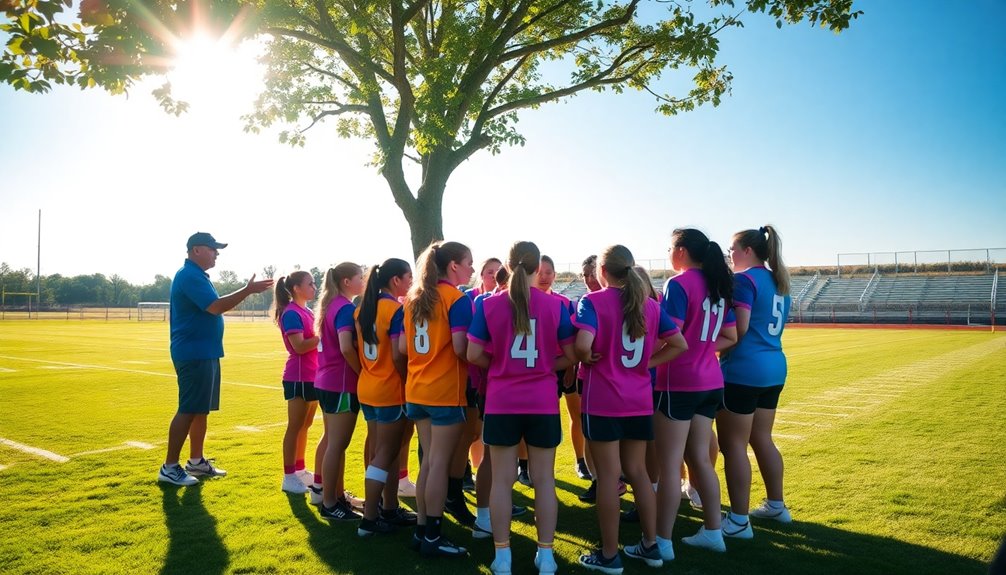
Top Strategies for Girls Flag Football Teams
January 4, 2025To boost your girls flag football team, focus on mastering the fundamentals while enhancing communication. Make certain everyone understands their positions and the basic plays. Mix up offensive strategies with formations like Trips Right to keep defenders off balance. On defense, implement zone coverage techniques to guard against passes. Structure your practices for efficiency; dedicate time to offensive and defensive drills while incorporating real-game scenarios. Finally, build team cohesion through regular meetings and fun warm-ups. By strengthening these strategies, your team will enhance its performance and teamwork as they work towards your goals together.
Understanding Flag Football Basics
When you immerse yourself in flag football, you'll quickly realize it's a fast-paced, non-contact version of American football that's perfect for players of all skill levels. Understanding the flag football history helps you appreciate the game's evolution and how it became a popular choice for teams, especially girls. Each team typically consists of five or seven players, and knowing the defined player positions is vital. You'll find roles like quarterback, center, and various receivers, which allow for diverse and strategic play formations. Effective communication is crucial for organizing the defensive line and executing plays and routes, such as slants, outs, and posts. These routes create valuable passing opportunities and can dramatically change the game's flow. Familiarizing yourself with basic formations and routes is essential for both offensive and defensive strategies. They dictate how players position themselves and move at the line of scrimmage. Additionally, understanding the role of defending midfielders can enhance your team's ability to break up opponent plays effectively. Mastery of field positions is key to ensuring all players contribute to both offensive and defensive plays.
As you engage in drills and play, you'll notice that flag football encourages participation and skill development. Players often rotate positions, enhancing their understanding of the game's dynamics. Embrace these fundamentals, and you'll set the foundation for a successful flag football experience.
Essential Plays and Formations
Mastering essential plays and formations is fundamental for any flag football team aiming to elevate its game. Understanding key route types like the hitch, slant, and fly allows you to create effective plays that exploit defensive weaknesses. Each route serves a purpose, so practicing a combination of nine different types guarantees your offense can adapt to various game situations. Additionally, flag football teams, like soccer teams, thrive on teamwork, which enhances overall performance.
Utilizing formations such as Trips Right or Single-Back Criss-Cross can confuse defenders, opening up passing opportunities for your receivers. In a 5 on 5 format, simplified formations can lead to more effective execution, as all players run routes simultaneously. This synergy boosts your chances of success on the field.
Don't underestimate the significance of communication. When running crossing routes, coordinating movements and timing is essential for successful execution. Make sure your players are aware of their roles and are ready to adjust as needed. This includes developing team coordination which leads to cohesive gameplay.
Offensive Strategies for Success
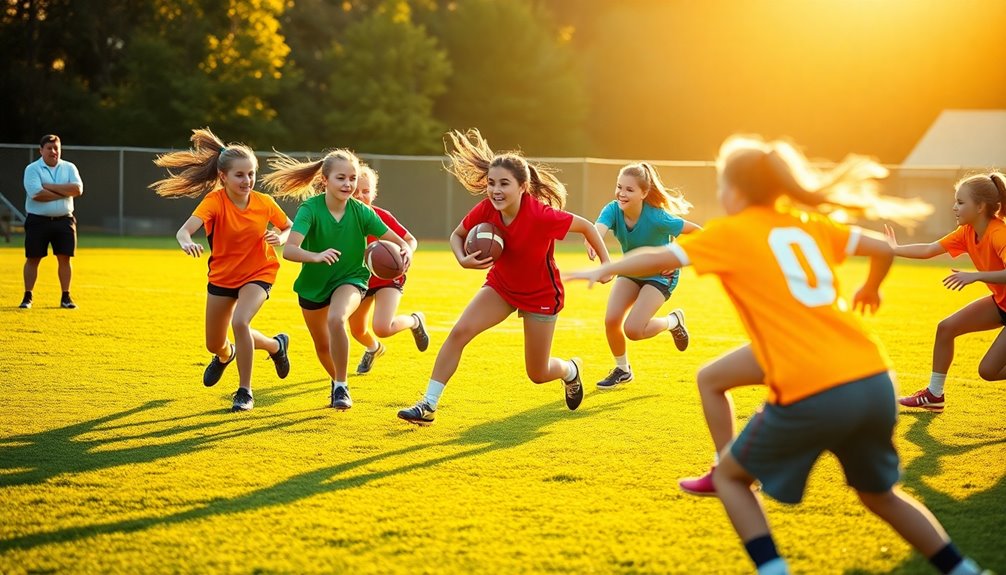
To achieve success on the field, you need a well-rounded offensive strategy that keeps defenders on their toes. By utilizing various offensive formations and passing techniques, your team can create confusion and open lanes for effective plays.
Here are some strategies to ponder:
- Diverse Routes: Implement routes like hitch, slant, and out to provide multiple passing options. This keeps defenders guessing and can lead to big plays. Additionally, using tactical flexibility allows your team to adapt to different defensive setups.
- Single-Back Criss-Cross: Use this play to exploit defensive confusion. Staggered slants can enhance your chances of quick yardage gains.
- Crossing Routes in 5-on-5: Focus on executing crossing routes to create mismatches. This approach opens passing lanes for your quarterback, increasing scoring opportunities.
- 7-on-7 Formations: Leverage the advantages of this format by mixing slot and wide receivers. This diversifies route options and maximizes quarterback mobility. Additionally, understanding formation strategies helps in adapting to the opponent's defensive setups effectively.
Defensive Techniques and Tips
A strong offense can easily overwhelm a defense if it isn't prepared. To stay competitive, focus on defensive positioning and employ effective coverage strategies. Use zone defense techniques to cover multiple receivers, allowing you to anticipate the quarterback's passes and react accordingly. Incorporating defensive stance drills can enhance your players' body positioning and agility, facilitating quicker reactions on the field. Engaging in agility training can significantly improve players' footwork, enabling them to shift directions swiftly.
Defensive communication is essential; guarantee everyone knows their assignments and can adjust based on the offensive movements.
Enhance your flag-pulling efficiency by implementing flag-pulling drills during practice. This skill is significant for stopping plays and can make a considerable difference in tight situations.
Also, encourage aggressive pursuit angles when closing in on the ball carrier. This approach helps cut off potential running lanes and forces the offense toward teammates.
Incorporate agility training and reaction drills to improve your overall speed and responsiveness. These skills are fundamental for effective defensive play in flag football.
Finally, develop anticipation skills to read the game better. By mastering these defensive techniques and tips, you'll create a formidable defense that can counter any offense. Additionally, emphasize the principle of compactness to maintain organization and limit space, which can further bolster your defensive effectiveness.
Effective Practice Philosophies
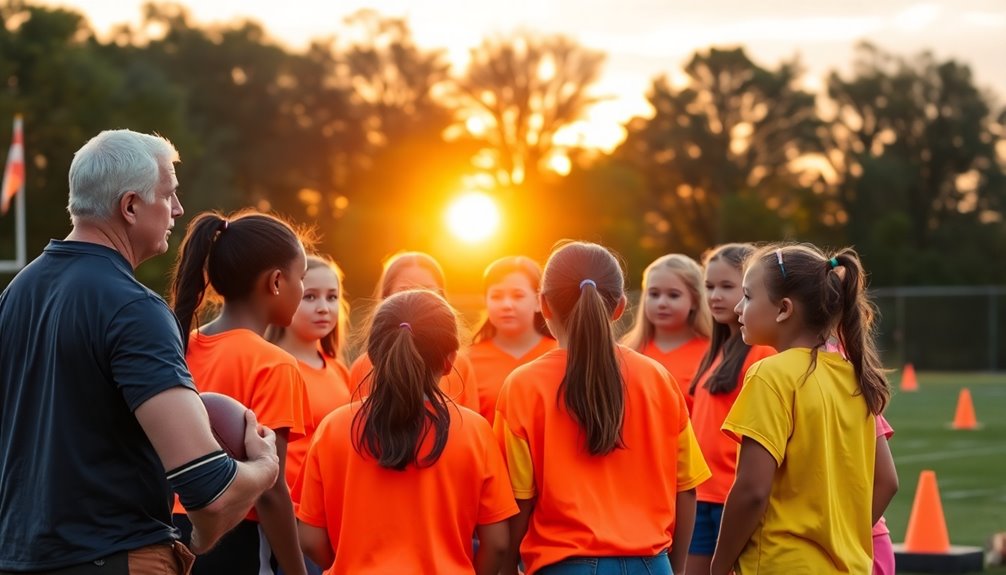
Creating an effective practice environment hinges on how you structure your sessions. By focusing on practice intensity and player motivation, you can elevate your team's performance. Here are four strategies to enhance your practices:
- Dedicated Time Allocation: Spend 45 minutes on offensive drills and just 10 on defensive strategies. This emphasis on offense boosts overall skill development.
- Repetition and Rotation: Focus on repeating specific plays to increase execution efficiency, while regularly rotating players. This keeps everyone engaged and ready to contribute.
- Active Participation: Guarantee all players are involved in drills to minimize distractions. An engaged team is a motivated team, which enhances practice intensity.
- Simulated Game Situations: Incorporate real-game scenarios to give players experience under pressure. This not only makes practices more realistic but also prepares them for actual games. Additionally, integrating high-intensity interval training (HIIT) can improve players' cardiovascular endurance, essential for maintaining performance during games.
Skill Development Through Drills
To build your team's skills effectively, focus on targeted drills that hone specific abilities. Incorporating game situation simulations will help players apply what they've learned in practice, while emphasizing teamwork and communication fosters a strong connection on the field. Additionally, encouraging effective communication among players enhances team spirit and coordination during drills and games. Incorporating teamwork enhancement exercises can further strengthen player bonds and improve collective effectiveness on the field. Moreover, utilizing agility drills can significantly boost players' maneuverability and reaction times, critical for success in fast-paced game situations.
Focused Skill Drills
While developing your skills in girls flag football, focused skill drills play an essential role in enhancing performance on the field.
These drills hone your technique and boost your confidence, allowing you to become a more effective player. Here are four key areas to focus on:
- Passing Drills: Prioritize passing accuracy by aiming for specific targets to improve your throwing mechanics and catching consistency.
- Route Precision: Incorporate route-running drills emphasizing different routes like slants and hitches. This practice sharpens your timing and movement precision.
- Agility Enhancement: Utilize cone drills to enhance agility and footwork. These exercises help you change direction quickly while maintaining control of the ball.
- Teamwork Exercises: Implement drills that encourage communication and teamwork. Practicing plays under pressure helps you build cohesion with your teammates.
Finally, don't forget about skill rotation.
Rotate players through various positions during drills to guarantee everyone develops a thorough skill set and becomes versatile contributors to the team.
#
Game Situation Simulations
Focused skill drills lay a solid foundation for any player, but adding game situation simulations takes your training to the next level. These simulations replicate real-game scenarios, allowing you to develop strategic thinking and decision-making skills under pressure.
By designing drills that focus on specific game situations, like two-minute drills or red zone scenarios, you enhance your ability to perform in significant moments.
Incorporate role-playing exercises where you assume different positions. This helps you understand your responsibilities and improves your overall performance during actual game situations.
It's important to practice situational drills that emphasize communication among teammates, as effective coordination is significant during high-stress moments in a game.
Regularly evaluating your performance in these simulated situations is essential. This allows you to identify areas for improvement and tailor future practices to address specific skills and strategies.
By integrating game scenario simulations into your training, you'll build confidence and adaptability on the field, equipping yourself to handle any pressure situation that comes your way.
Teamwork and Communication
Effective teamwork and communication are essential for success in girls flag football, and skill development through targeted drills can make a significant difference. By focusing on team dynamics and verbal cues during practice, you can enhance your team's performance on the field.
Here are some effective drills to implement:
- Crossing Routes: Use drills that involve crossing routes to foster communication. Players must call out their movements to avoid collisions and confusion.
- Route Verbalization: Encourage players to verbalize their routes and responsibilities during practice. This reinforces accountability and boosts teamwork during games.
- Small-Sided Games: Incorporate small-sided games that require quick decision-making in tight situations, promoting collaboration and enhancing team dynamics.
- Role Assignments: Assign specific roles during scrimmages. Clear communication about who's responsible for blocking, receiving, or running routes will help everyone stay informed.
Additionally, conduct regular team huddles to discuss strategies and reinforce the importance of verbal cues.
These practices create a cohesive environment where players feel confident and connected, ultimately leading to greater success on the field.
Importance of Team Communication
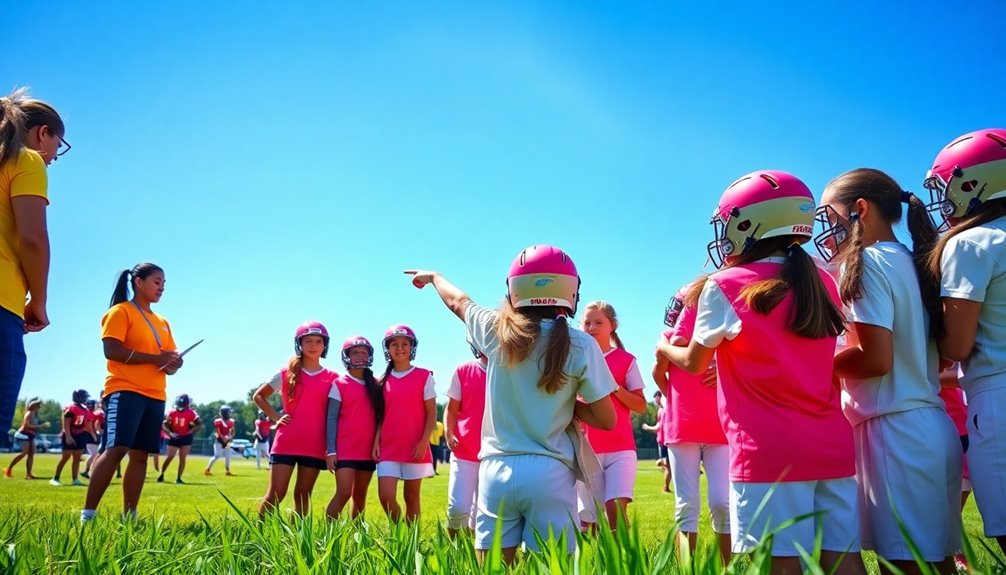
Effective communication on the field can really elevate your game.
When you and your teammates share signals and strategies, it not only enhances play execution but also builds trust among you all.
Plus, being able to adjust your tactics in real-time can give your team the edge you need to succeed. Additionally, fostering community bonds among teammates strengthens relationships, boosting overall team performance.
Enhancing Play Execution
In any team sport, communication plays an essential role in executing plays successfully, especially in girls flag football. To enhance play execution, focus on these strategies that promote effective communication among your team:
- Develop Common Terminology: Create specific terms for plays and routes. This clarity will speed up play recognition and help everyone understand their roles quickly.
- Utilize Hand Signals: Implement non-verbal cues to communicate during games. This allows your team to maintain route precision without tipping off opponents.
- Conduct Regular Team Meetings: Use these sessions to discuss strategies and review game footage. This practice improves communication skills and fosters a deeper understanding of both offensive and defensive tactics.
- Call Out Defensive Alignments: During plays, emphasize the importance of shouting out defensive setups. This helps players make informed decisions and adapt their strategies on the fly.
Building Trust Among Players
Building trust among players is fundamental for a successful girls flag football team. Effective communication fosters reliance on each other, especially during significant game situations. When players feel comfortable expressing their thoughts and concerns, it creates a positive team culture, enhancing overall morale.
Regular team meetings and practice discussions clarify roles and expectations, ensuring every player knows their responsibilities on the field. Incorporating trust exercises outside of practice can strengthen relationships and improve communication skills, making your team more cohesive.
Encouraging player feedback during practices is imperative. Constructive feedback promotes accountability and shared responsibility, which are essential components of trust. When teammates feel they can give and receive input without fear, it builds a supportive environment that translates into better performance during games.
Adjusting Strategies on Field
On the field, seamless communication is essential for adjusting strategies in real-time during a game. When you and your teammates effectively communicate, you can quickly adapt your routes and exploit defensive weaknesses.
Here are four key strategies to enhance team communication for successful field adjustments:
- Use Clear Verbal Signals: Establish specific calls for different plays to guarantee everyone is on the same page.
- Employ Non-Verbal Cues: Create hand signals or gestures that indicate changes in strategy without alerting the defense.
- Practice Complex Plays: Regularly run drills on crossing routes and other intricate plays to improve anticipation of each other's movements.
- Designate Roles: Have a clear communication system between the quarterback and receivers to streamline execution and minimize confusion.
Encouraging open dialogue fosters a collaborative environment, boosting morale and teamwork.
By focusing on signal recognition and practicing these strategies, you'll enhance your team's ability to adjust on the fly, leading to greater success in girls flag football.
Engaging Warm-Up Routine
A well-structured warm-up routine can set the tone for an engaging practice or game, energizing players both physically and mentally. Aim for a 10-minute session that incorporates dynamic stretches to prepare their muscles and increase blood flow. Start with movements like leg swings, arm circles, and high knees, ensuring everyone feels ready to play.
Next, focus on passing techniques by implementing two-line passing drills. This not only hones their skills but also enhances teamwork. Set a goal for each player to complete at least 30 passes, adjusting the distance based on age and ability. For younger players, use underhand tosses to boost their confidence and catching success rates.
Pair older players based on their abilities during these drills. This approach fosters tailored practice experiences, allowing them to learn from each other while developing essential skills.
Stretching and Injury Prevention
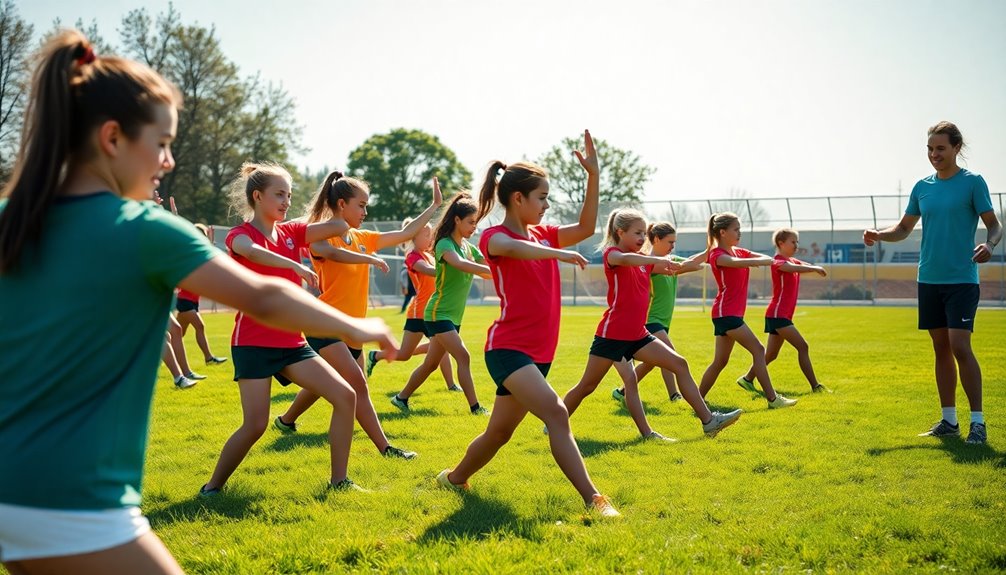
Incorporating a dynamic stretching routine for 5-10 minutes before practices is essential for enhancing flexibility and reducing injury risks in players. This practice not only prepares your muscles but also promotes injury awareness among team members.
Here are some effective dynamic stretches to include:
- Leg Swings: Swing your leg forward and backward to loosen up the hip joints.
- Arm Circles: Rotate your arms in large circles to warm up your shoulders.
- High Knees: Jog in place while bringing your knees up to your chest to activate your core.
- Lateral Lunges: Step to the side, bending one knee while keeping the other leg straight to stretch your inner thighs.
Assign different players to lead these stretching sessions. This fosters leadership skills while ensuring everyone engages in injury prevention practices.
Don't forget to emphasize the importance of warming up with light jogging and passing drills to prepare your body for the physical demands of flag football.
Additionally, educate players about hydration and nutrition as vital components of injury prevention and recovery during the season. Keeping these strategies in mind will help you stay healthy and perform at your best!
## Game Situation Simulations
Incorporating realistic game scenarios into your practice can greatly sharpen your tactical skills.
Position-specific drills not only prepare you for various roles on the field but also enhance your ability to react under pressure.
Realistic Game Scenarios
During practice, implementing game situation simulations is essential for developing a team's ability to handle real-game pressures. By creating realistic game scenarios, you help players enhance their situational awareness and understand game dynamics.
Here are some key aspects to focus on during these simulations:
- Third Down Conversions: Practice different strategies to convert on third down, emphasizing quick decision-making.
- Red Zone Plays: Simulate plays in the red zone to teach players how to capitalize under tight conditions.
- Time Management: Incorporate time constraints to replicate last-minute drives, helping players learn to manage the clock effectively.
- Defensive Adaptation: Introduce various defensive formations, challenging offensive players to adjust their routes and plays accordingly.
After each simulation, hold feedback sessions to analyze performance. Discuss what worked well and identify areas for improvement.
This not only reinforces learning but also fosters a culture of continuous adaptation. By focusing on these realistic game scenarios, you equip your players with the skills necessary to thrive under pressure, ensuring they're ready for any challenge that comes their way during actual games.
Position-Specific Drills
Position-specific drills play an essential role in preparing players for the demands of a game. By implementing game situation simulations tailored to specific positions, you allow your players to practice their roles under realistic conditions, enhancing their decision-making skills during actual gameplay.
Start with a thorough position analysis and skill assessment for each player to guarantee they're placed in the right scenarios.
For quarterbacks, create high-pressure situations where they must read defenses and make quick throws. This not only improves their reaction times but also hones their accuracy.
For receivers, design drills that involve route running under defensive pressure, so they learn to make sharp cuts while maintaining focus despite being guarded.
Defensive players also benefit from simulations of various offensive plays, allowing them to practice coverage techniques and anticipate receiver movements effectively.
Don't forget to include team scrimmages where players rotate positions. This approach fosters a deeper understanding of teamwork and positional responsibilities, guaranteeing that every player gains experience in different game situations.
Ultimately, these position-specific drills prepare your team to perform at their best when it counts.
Building Team Cohesion and Leadership
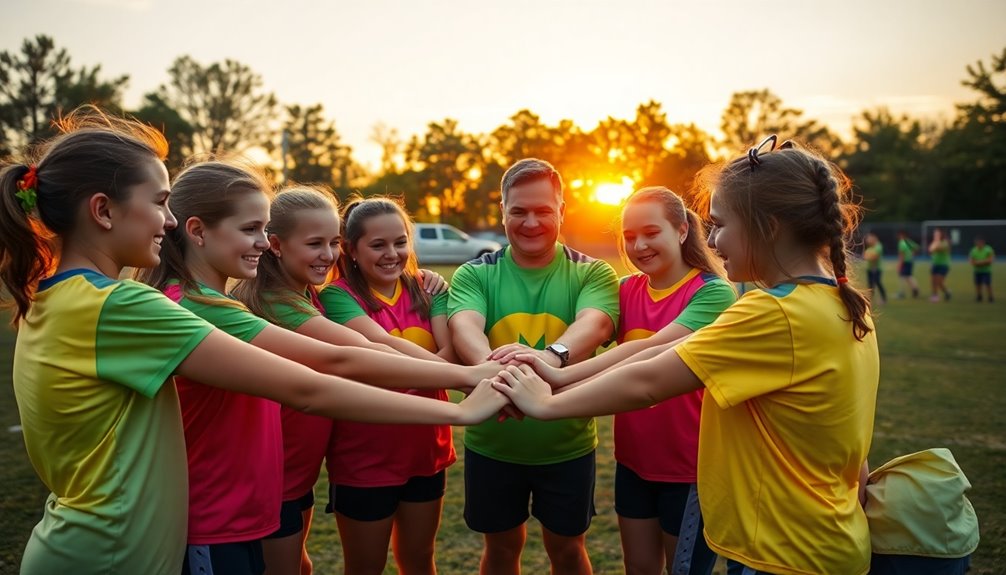
Team cohesion is essential for success in girls flag football, and it starts with effective communication. By establishing regular team meetings, you create an environment where players can express ideas and concerns openly. This enhances trust and unity among teammates, which is crucial for building strong relationships.
To foster team cohesion and leadership, consider these strategies:
- Implement Team-Building Activities: Engage in trust exercises and goal-setting activities both on and off the field to strengthen relationships.
- Assign Leadership Roles: Empower players by assigning roles like team captains. This promotes accountability and encourages leadership development within the team.
- Encourage Peer Mentorship: Create opportunities for experienced players to act as role models, helping younger teammates build confidence and skills.
- Celebrate Achievements: Recognize both individual and team accomplishments during feedback sessions. This boosts morale and reinforces team values, making everyone feel included.
Conclusion
To sum up, mastering these top strategies can greatly elevate your girls' flag football team. Did you know that teams with strong communication on the field win 25% more games? By focusing on effective practices, solid offensive and defensive plays, and team cohesion, you can create a winning culture. Remember, it's not just about the game; it's about building confidence and friendships that last beyond the field. Get out there, implement these strategies, and watch your team shine!


